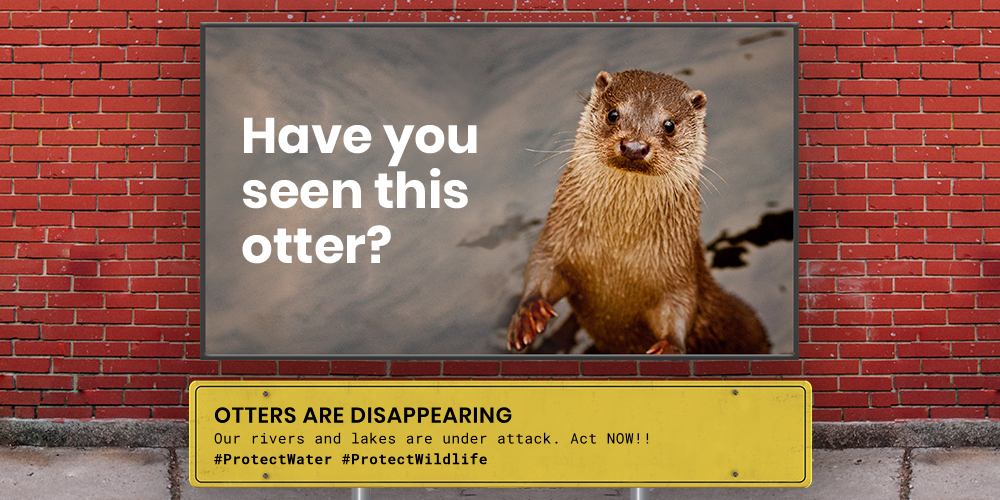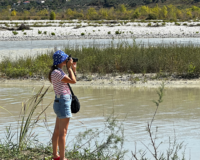
The rivers and lakes that otters and dragonflies call home are being destroyed in Europe.
Act NOW to protect their homes.
THE OTTER

Otters reach a body length of 100 to 130 cm or 140 cm if the tail is included.
Otters live on land and in water. They are found in rivers, streams, lakes and lagoons. Otters prefer areas with a lot of vegetation: on the shore or in the river bed.
Otters are very good divers and can stay underwater for up to 10 minutes.
The otter weighs from 7 to 12 kg.
Otters have a thick brown fur that protects them from the cold and wetness of the water.
Otters may look social, but they are actually solitary, with males and females only coming together during mating.
Otters prefer to sleep during the day and conserve energy to initiate activity at night.
Much of the otters’ food comes from water: fish and crabs are the main ones. For a change sometimes, they hunt on the ground for birds, eggs, insects and small animals.
They usually eat more than 1 kg of food per day.
Otters give birth to two or three cubs, which are born blind and open their eyes after 1 month and begin to leave the nest after 2-3 months.
Baby otters are not born swimmers, and their bloated gills make this even more difficult, so they are usually pulled into the water by their mother when they are 16 weeks old.
They learn quickly and begin to catch their own food.
Baby otters stay with their mother for up to 14 months and reach sexual maturity at 2-3 years of age.
Otters are members of the Mustid family.
Otters have keen sight, smell and hearing. Their eyes are located high on their heads, so they can see well when the rest of their body is underwater.
Otters communicate using vocal sounds, such as the whistles and chirping of birds
Over 100 different otter scent components have been identified. About 17 of them are thought to contain information about sex, age and even individual recognition, which can be used by other otters.
The dragonfly

Dragonflies are ancient! A long time ago, dragonflies conquered the air: the ancestors of the modern dragonfly existed 300 million years ago!
Once hatched, dragonfly nymphs hunt other aquatic invertebrates. They feed on small fish as well as other larvae.
Dragonflies are aquatic species. They deposit their eggs on the surface of the water, or in some cases, embed them in aquatic plants or mosses.
The life of a dragonfly is no picnic. When they grow up, the nymph dragonflies crawl out of the water across rocks and plants and shed their skin for the last time. It takes about an hour for an adult to develop its body. This newly hatched dragonfly has a soft and pale body, making it easy prey for predators. In the first days, until their body is fully strengthened, they are weak flyers. As such, birds and other predators consume significant numbers of young dragonflies in their first few days as adults.
Like other insects, dragonflies have very good eyesight. This is because they have large eyes and almost 360-degree vision and can see a wider spectrum of colors than humans. Each of their eyes holds 30,000 lenses; a dragonfly uses about 80% of its brain to process all the visual information it receives. This wide vision helps dragonflies detect the movement of other insects and avoid collisions in flight.
Dragonflies can move each of their four wings independently. They can move each arm up and down and rotate them back and forth on the axis. Dragonflies can move straight ahead or down, can fly backwards, stop and hover, make turns, at full speed or in slow motion.
A dragonfly can fly forward at a speed of 30 miles per hour.
Competition for females is strong and males aggressively drive off their competitors. In some species, males designate and defend territory from other invaders.
Like any insect, dragonflies are technically heated externally, but they move their wings, using very fast movements to heat their bodies. Some dragonflies rely on solar energy to heat their bodies and position themselves as much as possible under the sun’s rays. Some even use their arms as reflectors, tilting them so that they cast light onto their bodies. On very hot days, dragonflies will take a position in such a way that their wings protect them from the excessive radiation of the sun.







